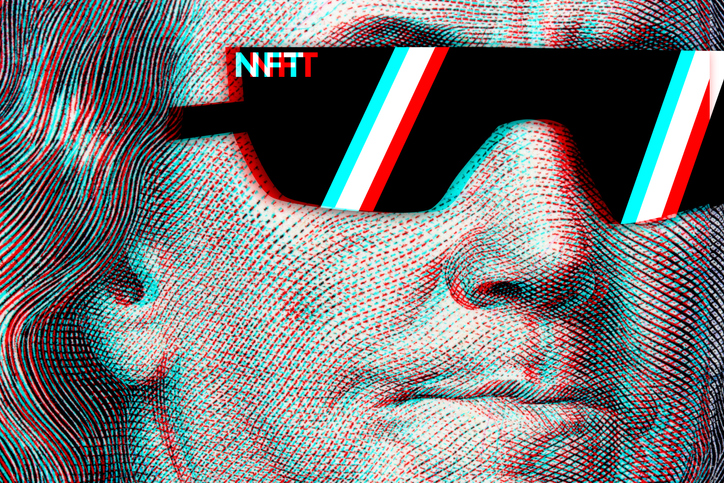The Non-Fungibility of NFTs

An understanding of history helps make sense of current tech trends. But it also breeds a false sense of security. Experience tends to make us think we've seen it all before.
Seen it before? Bought BTC for pennies? Better yet, did you scoop up any CryptoPunks when they were giving them away?
The CryptoPunks project
The world of NFTs: “the abbreviation of ‘non-fungible token’, the unique digital identifier that records ownership of a digital asset which has entered the mainstream and seen millions spent on the most sought-after images and videos, has been named Collins Word of the Year 2021,” says Collins Dictionary. “It is one of three tech-based words to make Collins’ longer list of ten words of the year.”
Wikipedia: “CryptoPunks was released in June of 2017 as one of the first non-fungible tokens (NFT) on the Ethereum blockchain.” The crypto art blockchain project originated from a two-person effort called Larva Labs, says Wikipedia, and “served as inspiration for the ERC-721 standard for NFTs and the modern crypto art movement, which has since become a part of the cryptocurrency and decentralized finance ecosystems on multiple blockchains...CryptoPunks are commonly credited with starting the NFT craze of 2021.”
A glance at a CryptoPunk doesn't affirm any grand vision of “crypto art.” They're childish 8-bit avatars with garish colors and jagged pixelation. Yet CryptoPunk #7523 was sold by Sotheby's on June 10, 2021, for a stonking USD11.75 million dollars, traded on the Ethereum blockchain.

However, the undisputed king of NFT price tags is Wisconsin-born Mike Winkelmann, better known as the digital artist Beeple. His works command top crypto in the world of NFT trading.
But how above-board is that world? It doesn't take a master criminal to realize that such sums will inspire money laundering strategies. And NFTs are cloaked in all sorts of new buzzwords and acronyms.
Pirates and plunderers
The perfect storm of rising crypto prices and the public's general lack of IT savvy creates a fertile environment for chicanery.
Sweden's Pirate Bay is famous and even inspired a 2013 documentary: “TPB AFK: The Pirate Bay Away from Keyboard.” And now we have The NFT Bay: a torrent site where anyone can download 15 terabytes of JPEGs of NFTs.
The perfect storm of rising crypto prices and the public's general lack of IT-savvy creates a fertile environment for chicanery
In November 2021, an art project (in the form of a file dump via torrent) highlights possible pitfalls. The NFT Bay is the brainchild of Australian Geoffrey Huntley, who describes himself as a “principal developer advocate.” The site is styled after The Pirate Bay and is intended to raise awareness about the nature of NFTs.
“Did you know that an NFT is just a hyperlink to an image that’s usually hosted on Google Drive or another web2.0 webhost?” writes Huntley on his Github account. “People are dropping millions on instructions on how to download images. That's why you can right-click save-as because they are standard images. The image is not stored in the blockchain contract.”
Common sense dictates that any image which can be saved by right-clicking from the Internet is not some unique and valuable object, but sometimes common sense isn't as common as it ought to be.
Washing dirty cash
Some insight into the feasibility of laundering funds through trading in NFTs is given by a pseudonymous crypto analyst known only as “Mr. Whale” on cryptowhale.medium.com. “NFT’s are risky because their future is so uncertain as there isn’t a lot of history to judge their performance,” writes Whale.
“I think it is possible that NFTs could be and are already being used to launder money in similar ways done with physical art,” says the Whale article. “It could possibly be even easier to move dirty funds around because it is tied to a decentralized currency and the fact that there are no physical artworks to have to transport or store in off-shore tax haven warehouses.”
NFT: Collins Word of the Year 2021
An article on NFT Innovation describes a conventional money laundering process and gives some insight into potential NFT-driven malfeasance. “So are NFT’s a good way to launder money?” asks the article. “The short answer would be yes.” The writer points out weak spots in the scheme: entry points where crypto is changed into fiat currency and law enforcement tracing transactions on the Ethereum public blockchain.
“With the know-your-customer principle that was already introduced into the physical art market, I am certain upcoming policies will force NFT marketplaces to identify its customers in the future,” says the NFT Innovation article. It's telling that these and similar FAQs on money laundering via NFT end with disclaimers explaining that it's illegal.
The tl;dr on NFTs
The recent rise in the value of mainstream cryptocurrencies creates excitement among get-rich-quick investors similar to the Dutch Tulip Mania of the 17th century. Just as in any scheme promising fast and easy ROI, scams are sure to follow.
This is not a world for casual investors or those seeking to get rich quickly. Caveat emptor.
Stefan Hammond is a contributing editor to CDOTrends. Best practices, the IoT, payment gateways, robotics, and the ongoing battle against cyberpirates pique his interest. You can reach him at [email protected].
Image credit: iStockphoto/gesrey







